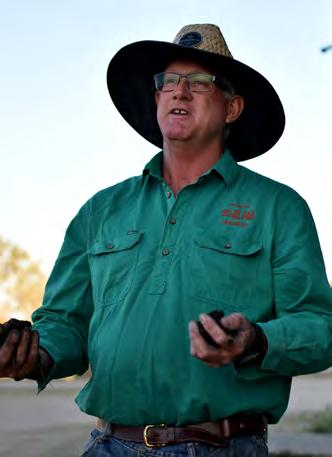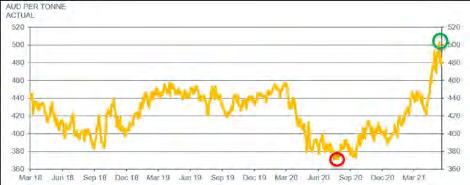
7 minute read
ON THE LAND

On the Land is proudly supported by
Advertisement


CuSTRING WELCOMES NAIF REFORMS TO POWER JOBS, GROWTH AND INVESTMENT IN THE NORTH.
CuString
PROPONENTS of CopperString 2.0, the high-voltage transmission line to connect the North West Minerals Province to the National Electricity Market near Townsville, have welcomed reforms to extend the reach and life of the Northern Australia Infrastructure Facility (NAIF).
CuString Chief Executive Officer Joseph O’Brien said the company was well advanced in its discussions with NAIF, the Australian Government’s dedicated lender to infrastructure projects and businesses in northern Australia, for what is expected to be NAIF’s largest loan.
“The Government’s review identified some reforms to make NAIF more effective. It is good news for Northern Australia and game-changing infrastructure projects such as CopperString, that the Parliament has passed these reforms,” Mr O’Brien said.
“As far as we’re concerned, the extension of NAIF for a further five years to 2026 is welcomed as their long-term debt is critical for major infrastructure.
“We’re motivated to finalise our NAIF arrangements and move into construction of CopperString, which is expected for completion in 2024.
“Like NAIF, CopperString will be a catalyst for significant industry and investment growth, so broadening the scope of projects that NAIF can support is also very welcomed.
“North Queensland can experience a boom as the world transitions to an electrified economy. We need major infrastructure investment to unlock this potential. That is good news for more jobs, growth and investment in the North and exactly what the nation needs to increase jobs after COVID-19,” Mr O’Brien said.
Mr O’Brien said CuString was continuing to work with NAIF, as well as working with the Queensland and Australian Governments, who strongly endorse the project, to finalise approvals.

New aquatic weed composting techniques improve soil health and crop yield
NQ Dry Tropics
NQ DRY TROPICS is working with five farmers to turn aquatic weeds sourced from local creeks into compost.
The aim is to turn problem weeds into a valuable on-farm resource, through cost-effective means, while controlling weeds in waterways.
Respected agro-ecologist David Hardwick of Soil Land Food, has been contracted to guide the growers through the composting process.
“My role is to show farmers how to make compost on-farm using low-cost, local resources that can be used in their soil for production benefits and soil health benefits,” Mr Hardwick said.
“Farmers are hesitant to use compost because of the price, and the cost of freight is an additional barrier.
“The approach being trialed is a fermentation compost, also known as a minimum or no-turn compost.
“Fermentation is where you mix your ingredients and add a bacterial inoculum to the compost heap, and then cover it to allow it to compost in a lowoxygen environment.
“It’s different from a normal turned compost because it uses a lot less resources, time, water and machinery to achieve a really good quality compost.
“Compost needs two main ingredients, called feedstock, carbon and nitrogen. The wood mulch is the carbon source and the water weeds are the nitrogen source.”
NQ Dry Tropics Waterways, Wetlands and Coasts Team Leader Scott Fry said the trial would not have been possible without funding support from the Queensland Governments’ Natural Resource Investment Program, and in-kind donations from Burdekin Shire Council and Lower Burdekin Water. They have provided the feedstock for the project.
“Council has donated mulch from its waste transfer facility and has provided access to aquatic weeds from the local creek systems,” Mr Fry said.
“Lower Burdekin Water is donating excavator time to remove the weeds from the creeks, and loading it onto trucks to be taken to participating farms.”
Growers have also made their own microbial inoculant for the compost.
“Making the inoculant is pretty straight forward using ingredients purchased from a local store,” Mr Fry said.
“The microbes do all the hard work breaking down the feedstock and converting it into a high grade compost.
“When forming the compost piles, we wet them to about 60 per cent moisture and the microbes are diluted and spread through the piles.”
The composting process will take about five months, and will be trialed on a range of crops to improve soil structure to help the sandier soils hold water for longer.
Third-generation farmer Gary Spotswood is participating in the trial. After experimenting with compost for a few years he said he was keen to trial a static compost pile.
“The idea of utilising everything that you have in your backyard such as water hyacinth and other aquatic weeds, is not only practical in terms of producing your own compost, but potentially will also be cost effective,” Mr Spotswood said.
“Being organic farmers, traceability is critical. We need to justify what product we use, and how and when we use it.
“Using a locally sourced natural resource to convert into a high quality compost is appealing. It means potentially reducing our use of conventional organic fertilisers and also reducing costs.
“David Hardwick’s input has been valuable. He’s been great in explaining how to manage the composting process in accordance with Australian composting standards, and the tests we can do to verify our organic standards.”
The project is part of NQ Dry Tropics’ Reducing Burdekin Sediment project, funded through the Queensland Government’s Natural Resource Investment Program.
Cane farmer Gary Spotswood
QSL Market Update current as of 19 May 2021

Sugar
• Market anticipation of the latest Brazilian crop numbers saw raw sugar prices soar to record contract highs of 18.25 USc/lb on Tuesday before the rally became too overwhelming and crashed back down below 17 US cents, closing the week at 16.96 USc/lb. • Bullish sentiment appeared to push speculators into pre-emptive buying the day before the fortnightly UNICA (Brazilian Sugarcane Industry Association) report was released as many expected weak sugar data and a further reduction in the cane crop. The actual results did not disappoint, as every category was significantly below last year’s figures. The cane crop as at 1 May 2021 was 25.44% lower than the same time last year at 45.259 million tonnes and sugar 28.51% lower at 2.148 million tonnes. • The bullish news from the UNICA report was overshadowed however by the US Consumer Price
Index (CPI – see our Jargon Buster) data release on the same day. The CPI printed at 4.2%, significantly above the expected 3.6% which sparked fears into investors of anticipated higher interest rates. All commodities across the board were lower as investors withdrew the money from the asset class. • As of Tuesday 11 May, speculators had added to their position, reaching the largest position held since October 2020 of 259,000 lots net long. This position is likely to be lower on a live basis after many investors were likely to have closed out their position on the back of the US CPI figures mentioned previously.
2021-SEASON HISTORICAL ICE 11 CHART

This is a whole-of-season ICE 11 price chart for the 2021 Season, based on the current 1:2:2:1 pricing ratio applicable to QSL Target Price Contract growers. Source: Bloomberg
Currency
• US Dollar strength saw the Australian Dollar trend downwards for the majority of the week from its high on
Monday at 78.91 US cents to the low on Thursday of 76.88
US cents. • The April Producer Price Index (PPI – see our Jargon
Buster) also exceeded expectations significantly, publishing a 6.2% change year on year. This figure, coupled with the strong CPI data, reinforces investor fear of rapidly increasing inflation in the US economy. Market attention will be focused on how the US Federal Reserve reacts to the data. • The AUD presented little reaction to the Australia federal budget announced on Tuesday night. The Treasurer revealed a forecast budget deficit of $106.6 billion in the 2021-22 financial year and surprised with large expansionary spending.
To read our full commentary in the QSL Market Update, please visit www.qsl.com.au or contact the Burdekin QSL team: Russell Campbell, Grower Relationship Manager 0408 248 385 Kristen Paterson, Grower Relationship Officer 0438 470 235 Rebecca Love, Grower Relationship Officer 0429 054 330
This report contains information of a general or summary nature. While all care is taken in the preparation of this report, the reliability, accuracy or completeness of the information provided in the document is not guaranteed. The update on marketing and pricing activity does not constitute financial, investment advice. You should seek your own financial advice. Nothing contained in this report should be relied upon as a representation as to future matters. Information about past performance is not an indication of future performance. QSL does not accept any responsibility to any person for the decisions and actions taken by that person with respect to any of the information contained in this report.






